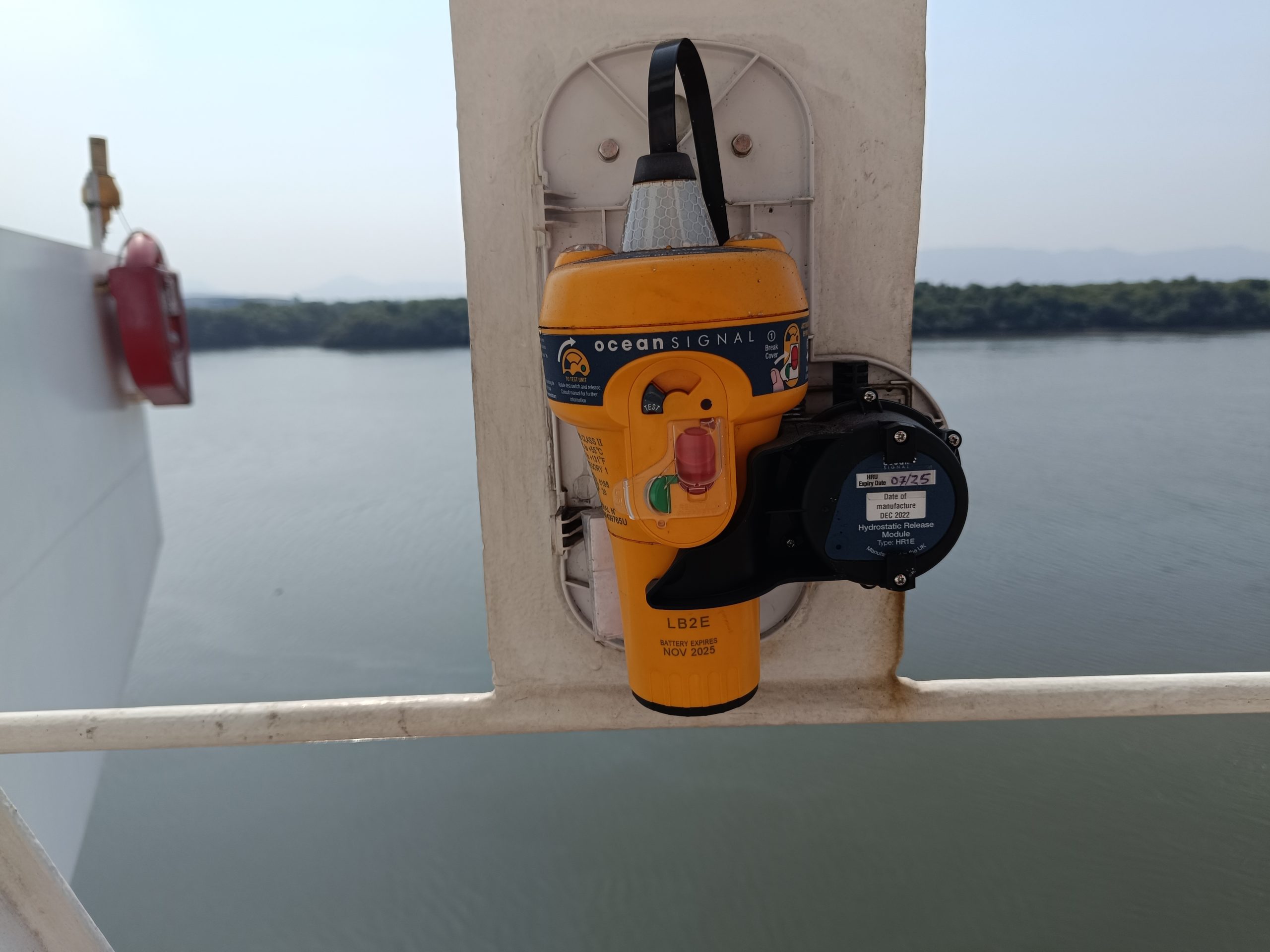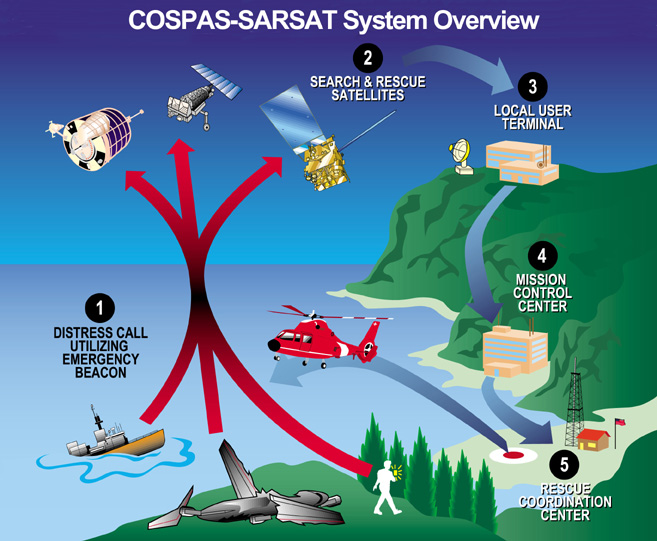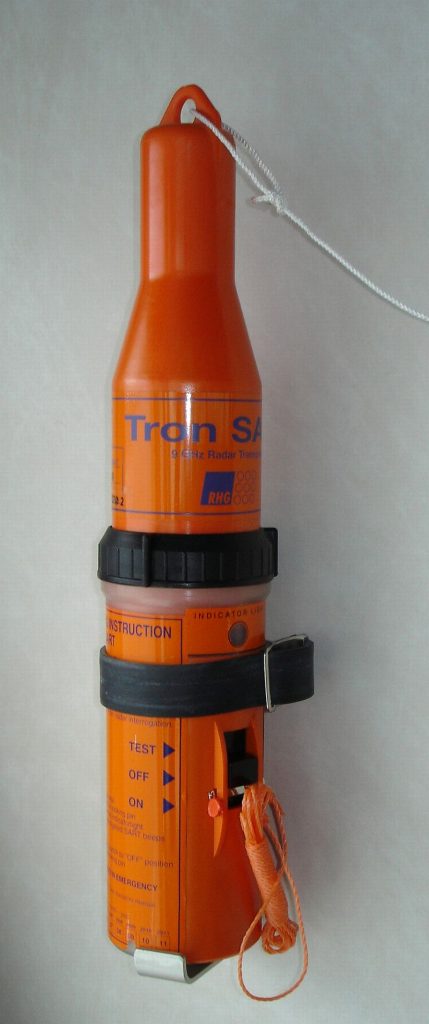Introduction
The use of modern satellite-based EPIRB systems started in 1989. In this article, we delve deeper into what EPIRBs are, and how they function to save lives.

A Category 1 EPIRB onboard a ship
Key Takeaways
-
EPIRB is a crucial distress signaling equipment, especially for vessels that make international voyages.
-
EPIRB provides the initial intimation and once rescue ships are nearby, the SART is activated to provide a more accurate location
-
EPIRB can be activated automatically or manually. Category 1 EPIRBs can also be deployed automatically
What Is the Emergency Position Indicating Radio Beacon (EPIRB) and its function?
The Emergency Position Indicating Radio Beacon (EPIRB) is a distress alert equipment that transmits distress signals to a coast station in emergencies. The EPIRB signal cannot be detected by nearby vessels. The beacon activates automatically in emergencies upon contact with water. We can also activate it manually if required.
The EPIRB operates on a dedicated rescue frequency of 406 MHz and has worldwide all-weather distress signaling capability. The 406 MHz signal is more stable and accurate than the previously used 121.3 MHz signal.

The EPIRB signal is picked up by geostationary earth-orbiting satellites (GOES) that relay them to the nearest Rescue Coordination Center. GOES, or specifically, the COSPAS SARSAT satellite can instantly pick up the signal from almost anywhere on the globe. The signal contains all of the information provided when the EPIRB was registered. This includes the ship’s identification, type and size, event date, and position.
It is important to note here that an EPIRB is a secondary distress signaling equipment and must only be used as a last resort after other means of distress signaling equipment such as flares and radios have been used.
Difference between SART and EPIRB
SART and EPIRB are both rescue system beacons used on ships but there are many differences between the two.
SART stands for Search and Rescue Radar Transponder. Unlike EPIRB which communicates with satellites, a SART communicates with other vessels through the X-band radar. SART works on a 9 GHz frequency which can be picked up by X-band radars operating within a frequency of 8 to 10 GHz.

As a result, SART has limited coverage compared to the EPIRB’s global coverage. SART can only be effective when there is another ship nearby with X-band RADAR.
One more difference is how they are activated. While an EPIRB can be automatically or manually activated, a SART only has manual activation. This is why, during lifeboat drills, a deputed crew member carries the SART to the lifeboat so that it can be activated manually if the crew abandons the ship.
There is also a difference in the duration of the operation. While an EPIRB works continuously for 48 hours, SART can only work for 8 hours in transmission mode. Its standby time, however, is 96 hours.
The EPIRB is only used as a homing signal to alert the Land Earth Station (LES). The LES then relays this signal to nearby ships, RCC, MRCC, and the coast guard to initiate rescue efforts. However, once rescue teams are nearby, the ship crew must put SART into use. This enables nearby ships and aircraft to track the ship crew at sea.
EPIRB test procedure
EPIRBs are required to be tested every month. When we need to carry out a test, they must be performed within the first 5 minutes of an hour. We can usually find the EPIRB on the bridge wings or the monkey island of a merchant ship. Follow the following steps to test an EPIRB:
-
Open the safety pin on the automatic release housing and remove the cover.
-
Take the EPIRB out of the housing.
-
Move the switch position to the Test mode and hold it there for about 15 seconds. Note that we do not need to pull the strap for EPIRB testing.
-
Observe the light at the top of the antenna. The light will flash once to confirm successful testing.
-
Release the switch from the Test mode position and bring it back to the Ready position.
-
Restore the EPIRB in the automatic release housing and secure the cover with the safety pin.
-
Record the test in the GMDSS log book.
How is an EPIRB activated?
The activation of an EPIRB is a serious matter as they are taken at face value by rescue centers. It must only be done when in grave or imminent danger. An EPIRB can be activated either manually or automatically.
The automatic activation feature comes into effect when the EPIRB comes into contact with the water. The HRU disconnects the EPIRB from the vessel. As the EPIRB is a buoyant and waterproof beacon, it floats to the surface. The seawater completes the circuit through the terminals at the bottom of the EPIRB and the beacon starts a continuous transmission automatically.
Should this occur, the EPIRB must be secured to the lifejacket or the lifeboat/liferaft to ensure it doesn’t proximity.
We can also activate an EPIRB manually. The general steps for a manual activation are as follows.
-
Remove the EPIRB from the automatic release housing on the bridge wings.
-
Extend the antenna as far as it goes. Some EPIRBs, however, have fixed antennas that do not need to be extended.
-
Remove the break-off tab.
-
Lift the flap.
-
Move the switch from the Ready position to the ON position to activate the EPIRB manually.
-
An LED flashes to show activation.
-
Release the pressed key.
-
The strobe light starts flashing to show activation.
-
Extend the coiled lanyard and throw the EPIRB in the water while holding the free end of the lanyard.
Difference between Category 1 and Category 2 EPIRB
EPIRBs come in two categories: Category 1 and Category 2.
Category 1 and 2 EPIRBs can automatically activate if they fall into the water. The two, however, differ in their deployment method.
The Category 1 EPIRB has a Hydrostatic Release Unit or HRU for automatic deployment. The HRU enables the EPIRB to break off and float to the surface when the vessel sinks 1.5 to 3 meters below the water. The HRU may need a replacement every two years or more.
On the other hand, a Category 2 EPIRB cannot deploy automatically. In an emergency, the beacon must be dropped into the water for automatic activation.
The additional features in a Category 1 EPIRB make it more expensive than a Category 2 EPIRB. Category 1 EPIRBs are generally found on larger vessels while category 2 EPIRBs are more appropriate for vessels that stay near the coast.
Frequently Asked Questions
Where is EPIRB located on a ship?
The manual EPIRB is located at the bridge. The automatic EPIRBs are located either on the bridge wing or the monkey island. This intention is to prevent the EPIRB from getting entangled into obstacles when a vessel sinks and the EPIRB is released automatically.
What is the range of an EPIRB?
The range of a modern 406 MHz EPIRB is worldwide. However, it can only be accurate within a two to five-km location. This can be rectified by using EPIRBs with inbuilt GPS (GPIRB).
Can an EPIRB alert be canceled?
If an alert is sent inadvertently, it can be canceled immediately by moving the switch to the Ready position and contacting the nearest Coast Guard to inform the rescue coordination center.
What are the three types of EPIRB?
The three types of EPIRB are COSPAS SARSAT, INMARSAT E, and VHF Ch 70.
What is the battery life of an EPIRB?
Depending on the make and model, the battery life of an EPIRB may be 2 years, 5 years or more.

Leave a Reply